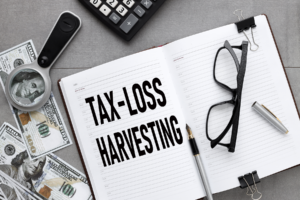Tax-loss Harvesting
May 2, 2025
To Inform:

Realizing that we are comfortably through the April 15th tax filing deadline (for those of you not on extension) we don’t want to look at tax planning as simply a thing we think about when you file your return. As Wealth Advisors we want tax to be a planning topic we touch on to some extent year-round. The strategy of tax-loss harvesting is a tool that can be beneficial for many clients to utilize in up and down markets to mitigate current and future tax. The government taxes capital gains (short-term and long-term), so it is also fitting that they allow us to apply capital losses against income. Here are the basics of tax-loss harvesting:
What? Tax-loss harvesting is when you sell a portfolio asset at a current loss to utilize against a gain now and/or in the future, while purchasing a similar investment (not the exact one) to take the place of the asset sold in order to maintain investment in markets. As long as the investment is not considered identical, you avoid what’s called a wash sale which otherwise would eliminate any realized loss should you purchase an identical security.
Benefits:
- Offset capital gains – Reduces taxes owned on profitable investments.
- Offset ordinary income – If there are no gains in an account, up to $3,000 per year can be used to reduce taxable income and anything over this can be carried forward in perpetuity.
- Take advantage of market downturns – Turns losses in volatile markets into tax-saving opportunities.
- Tax bracket planning – This strategy is most beneficial when individuals are in larger tax brackets. In general, the larger the tax bracket, the more you can save on tax.
When? Some tax-related transactions can cross over the calendar year. For example, IRA contribution made before 2026’s tax deadline can be filed as a 2025 contribution. However, tax-loss harvest transactions must occur prior to December 31st to count for that tax year.
Where? Tax-loss harvesting can be done in taxable accounts such as brokerage, joint brokerage, and Trust accounts which hold individual stocks or exchange traded funds. The purpose here is to offset taxable gains. Within tax-deferred accounts like 401ks, 403bs, IRAs, etc. this opportunity is not available because those accounts have the benefit of tax deferral until funds are withdrawn.
Why? As Ann Landers said, “A person doesn’t know how much he has to be thankful for until he has to pay taxes on it.” Taxes could be considered a blessing because we are not taxed unless we have income. But when it comes to long-term tax planning, it is ideal to limit taxes over an individual’s lifetime and tax-loss harvesting is a strategy that can be utilized to help accomplish this goal.
How? A full discussion will likely be needed with your financial representative throughout this part of your life. A portfolio manager, accountant, and of course your financial advisor will likely all need to be a part of these conversations as well as entering “sell” and “buy” orders within an account to accomplish this harvest of losses. A 1099 will be distributed at the beginning of the following year to indicate any gain or loss recognized for the previous tax year.
For any questions regarding your current portfolio and whether this may be a beneficial strategy for you, reach out to us. We’ll work with you and your tax professional to review your situation and help decide if tax-loss harvesting might work in your plan.

Written by Alex Jenney, Wealth Advisory Associate